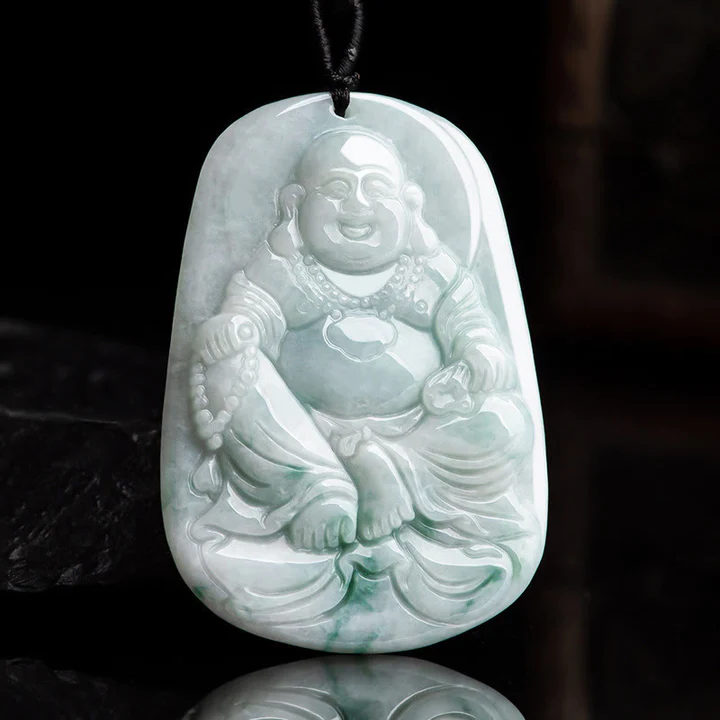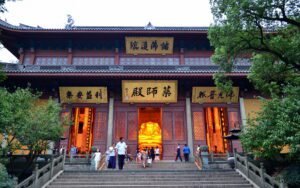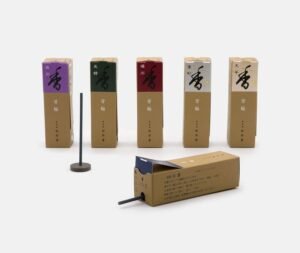Introduction
A Buddha necklace is far more than a decorative accessory or fashion statement—it’s a powerful spiritual symbol that carries centuries of wisdom, intention, and meaning. These sacred pendants have transcended their religious origins to become profound symbols of peace, enlightenment, and mindfulness for people of all backgrounds.
Whether you’re drawn to the serene countenance of the Buddha for spiritual practice, personal growth, or aesthetic appreciation, understanding the rich tapestry of meaning behind these mindful adornments can deepen your connection to the piece and enhance your spiritual journey.
In this comprehensive guide, we’ll explore the historical origins, symbolic meanings, material variations, and practical considerations for selecting the perfect Buddha necklace that resonates with your personal intentions and spiritual aspirations.
Disclaimer:
We earn a commission at no extra cost to you if you click a link and make a purchase
Table of Contents
The Historical Background of the Buddha Image
The Birth and Enlightenment of Siddhartha Gautama
The story of the Buddha begins with Siddhartha Gautama, born around 563 BCE in Lumbini (present-day Nepal) into royal privilege. Despite his luxurious upbringing, Siddhartha abandoned palace life after witnessing the suffering of common people outside the palace walls. His quest for understanding led him to renounce material possessions and pursue spiritual enlightenment.
After years of rigorous meditation and ascetic practices, Siddhartha achieved enlightenment under the Bodhi tree in Bodh Gaya, India. This profound spiritual awakening transformed him into “the Buddha”—the Awakened One—who spent the remainder of his life sharing his insights into the nature of suffering and the path to liberation.
The Buddha’s teachings, collectively known as the Dharma, center around the Four Noble Truths and the Eightfold Path. These principles continue to provide spiritual guidance to millions worldwide, offering a practical framework for ending suffering and attaining inner peace. Oxford Research Encyclopedia
Evolution of Buddha Imagery in Art and Sculpture
During the first few centuries after the Buddha’s death, his followers represented him through symbolic forms rather than human imagery. Early Buddhist art depicted the Buddha’s presence through emblems like the Bodhi tree, the Dharma wheel (Dharmachakra), footprints, or an empty throne—aniconism that emphasized his transcendence beyond physical form.
It wasn’t until approximately the 1st century CE that anthropomorphic representations of the Buddha began to appear, emerging simultaneously in the Gandhara region (modern-day Pakistan) and Mathura in northern India. These early depictions established the iconographic traditions that would evolve across different Buddhist cultures:
- Gandharan Buddha images showed Greco-Roman influence with realistic proportions and flowing robes
- Mathura style featured more indigenous Indian characteristics with symbolic attributes
As Buddhism spread throughout Asia, Buddha imagery evolved to reflect local cultural aesthetics while maintaining certain standardized attributes known as lakshanas—the 32 physical characteristics of a Buddha that symbolize his spiritual attainment. These include the ushnisha (cranial protuberance), elongated earlobes, and the urna (spiral hair between the eyebrows). Metropolitan Museum of Art
The Inclusion of Buddha Images in Jewelry
The tradition of incorporating sacred Buddhist imagery into personal adornments has ancient roots. Initially, these devotional objects were primarily worn by monastics and devout practitioners as meditation aids and reminders of spiritual commitments.
As Buddhism expanded geographically and interacted with diverse cultures, Buddha pendants and amulets gained popularity among laypeople seeking protection, blessings, and spiritual connection in their daily lives. Historical evidence shows Buddha amulets from as early as the 7th-8th centuries in regions like Thailand, where they were believed to confer protective powers and merit to the wearer.
The contemporary popularity of Buddha necklaces represents a fascinating intersection of traditional spiritual practice, cultural appreciation, and modern fashion sensibilities. Today’s Buddha pendants range from authentic ritual objects used in Buddhist practice to artistic interpretations that honor the philosophical ideals of peace, compassion, and mindfulness that the Buddha embodies.
Dr. Emma Watson, a religious studies professor at Columbia University, notes: “The Buddha image in jewelry represents a democratization of spiritual symbolism, allowing individuals to carry these powerful reminders of enlightenment, compassion, and mindfulness with them throughout their daily lives.” Journal of Buddhist Ethics

Types of Buddha Necklaces and Their Meanings
Buddha necklaces come in various forms, each depicting the Buddha in different postures (mudras) that represent specific aspects of his teachings and spiritual journey. Understanding these variations can help you select a pendant that aligns with your personal spiritual intentions.
The Laughing Buddha (Budai)
The Laughing Buddha, with his rotund belly, broad smile, and sack of treasures, is one of the most recognizable and beloved Buddha figures worldwide. However, this image doesn’t actually represent Siddhartha Gautama but rather Budai (or Hotei in Japanese tradition), a semi-historical Chinese monk who lived during the 10th century CE and is believed by some to be an incarnation of Maitreya, the future Buddha.
The Laughing Buddha symbolizes abundance, contentment, and generosity. His joyful demeanor reminds us to approach life with good humor, while his round belly represents prosperity and satisfaction. The cloth sack he carries is said to contain endless treasures that he shares with those in need, symbolizing limitless generosity.
Wearing a Laughing Buddha necklace can:
- Attract prosperity and good fortune
- Foster a joyful perspective during difficult times
- Promote generosity of spirit and material abundance
- Remind you to find contentment in the present moment
The Venerable Hsing Yun, founder of Fo Guang Shan, explains: “The Laughing Buddha reminds us that enlightenment is not always serious or solemn. True wisdom often comes with joy, acceptance, and the ability to laugh at life’s circumstances.” Buddha’s Light International Association
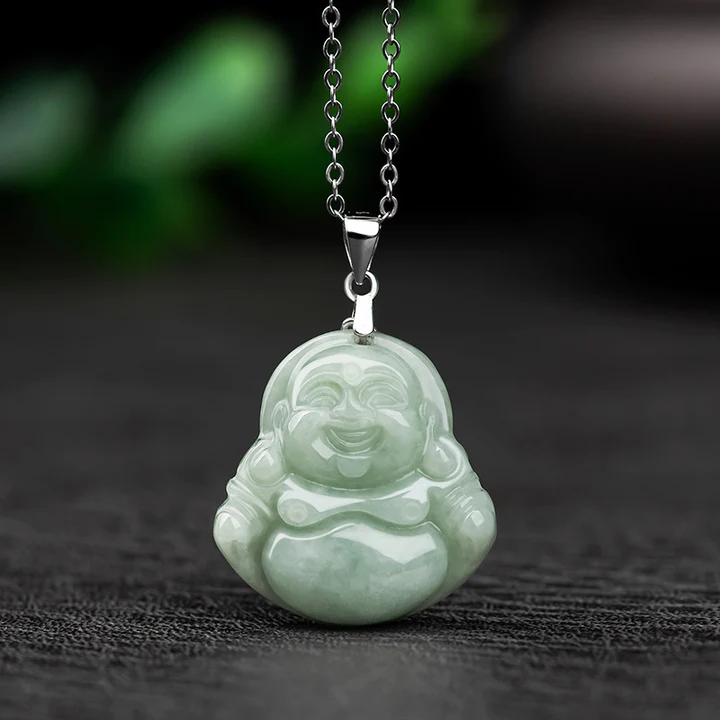
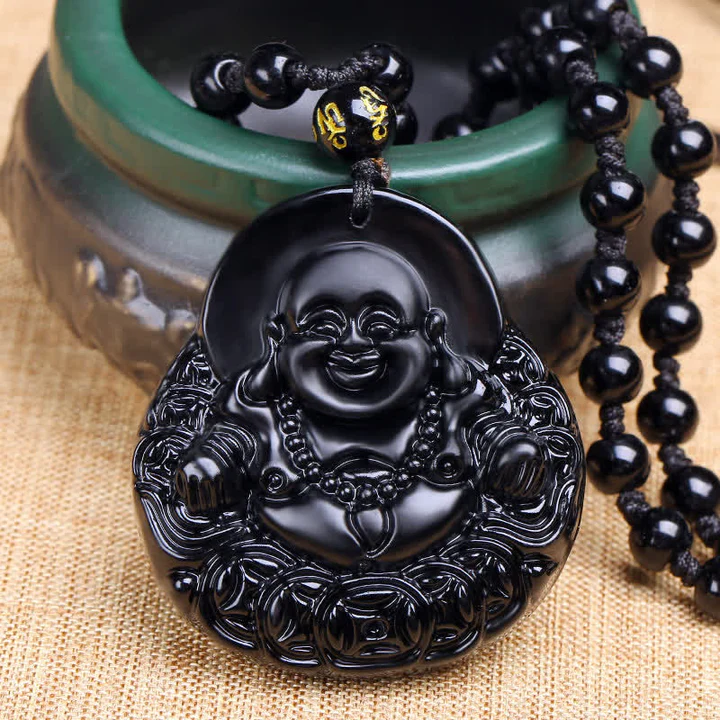
The Meditating Buddha (Dhyana Mudra)
The Meditating Buddha depicts Siddhartha Gautama in deep meditation, sitting in the lotus position with hands resting in his lap, palms facing upward with the right hand resting on the left. This classic posture, known as the Dhyana Mudra (meditation gesture), captures the Buddha during his quest for enlightenment under the Bodhi tree.
This representation symbolizes:
- Concentration and mental discipline
- Inner peace and spiritual equilibrium
- The path to enlightenment through mindfulness
- Detachment from worldly distractions
A Meditating Buddha necklace serves as a powerful reminder to cultivate mindfulness and inner calm amidst life’s challenges. It encourages the wearer to prioritize meditation practice and to approach life’s experiences with equanimity and presence.
Dr. Jon Kabat-Zinn, founder of Mindfulness-Based Stress Reduction, observes: “The image of the meditating Buddha reminds us of our own capacity for awareness and presence, inviting us to pause and reconnect with the present moment, our breath, and our true nature.” Center for Mindfulness
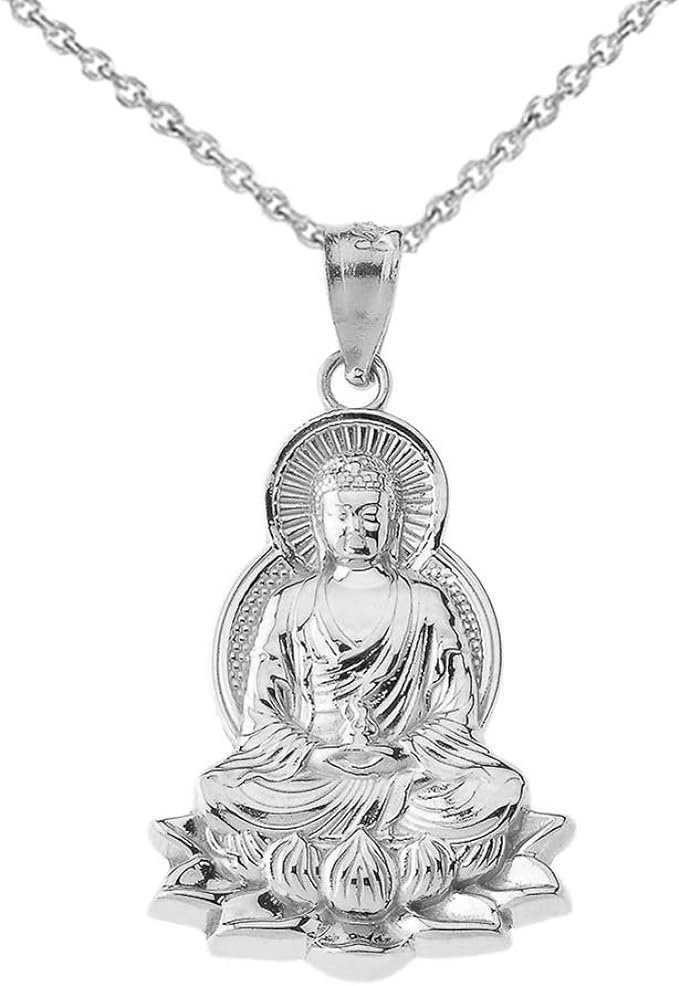
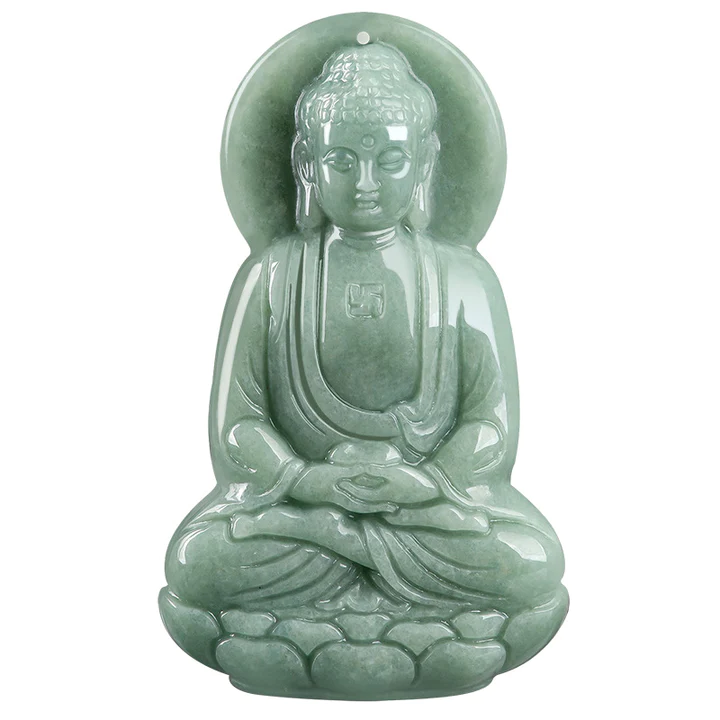
The Teaching Buddha (Vitarka Mudra)
The Teaching Buddha depicts Siddhartha Gautama with one or both hands raised, often with thumb and index finger forming a circle while the remaining fingers point upward. This hand position, known as the Vitarka Mudra (gesture of discussion), represents the moment when the Buddha first shared his insights after achieving enlightenment.
This sacred gesture symbolizes:
- The transmission of wisdom and spiritual knowledge
- The turning of the wheel of Dharma (Buddhist teachings)
- Intellectual discussion and reasoning
- The dispelling of ignorance through understanding
A Teaching Buddha necklace inspires intellectual curiosity and spiritual growth. It reminds the wearer of the importance of both learning and sharing wisdom with others, encouraging an open mind and heart in the pursuit of truth.
“The Teaching Buddha reminds us that enlightenment is not meant to be hoarded but shared compassionately with all beings,” explains Venerable Thubten Chodron, founder of Sravasti Abbey. Sravasti Abbey
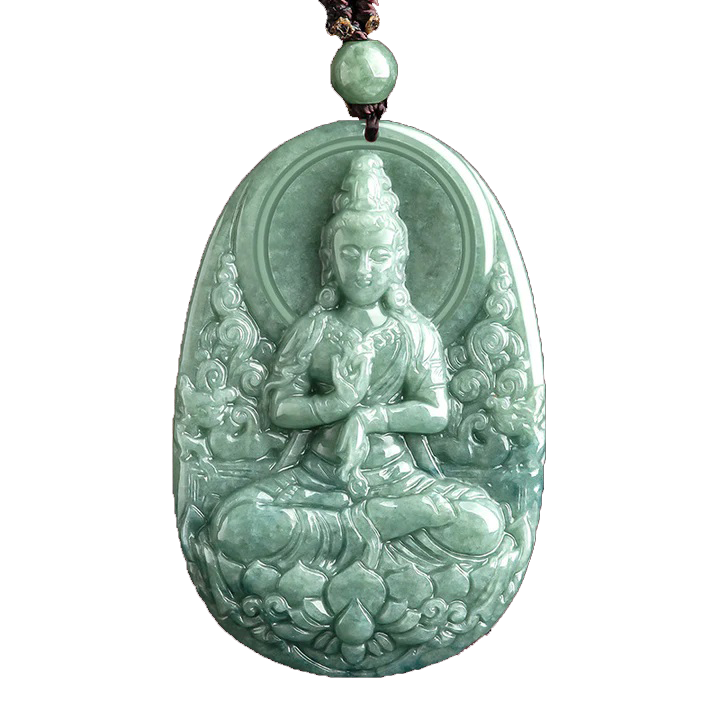
The Earth-Touching Buddha (Bhumisparsha Mudra)
The Earth-Touching Buddha portrays the pivotal moment when Siddhartha Gautama, on the verge of enlightenment, was challenged by Mara (the embodiment of temptation). As Mara questioned his worthiness to attain enlightenment, the Buddha touched the earth with his right hand, calling upon the earth goddess to witness his accumulated merit from countless previous lives.
This powerful gesture, known as the Bhumisparsha Mudra, symbolizes:
- Unshakable determination and spiritual resolve
- Victory over temptation and negative forces
- Connection to the earth and grounding
- The moment of enlightenment and transcendence
Wearing an Earth-Touching Buddha necklace connects you to your inner strength and resilience. It serves as a reminder that you have the power to overcome obstacles and challenges on your spiritual path, just as the Buddha conquered Mara’s temptations.

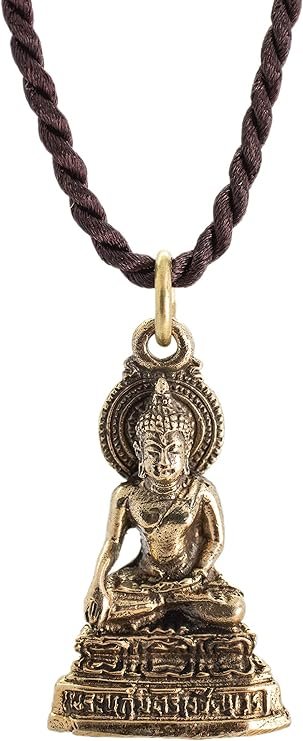
The Protection Buddha (Abhaya Mudra)
The Protection Buddha is depicted with the right hand raised, palm outward, in the Abhaya Mudra—the gesture of fearlessness and protection. This powerful symbol represents the Buddha’s ability to dispel fear and offer safety to all beings.
This mudra symbolizes:
- Courage in the face of adversity
- Protection from negative energies and harm
- Peace and the cessation of conflicts
- The removal of fear through spiritual understanding
A Protection Buddha necklace serves as a spiritual shield, offering comfort during challenging times and symbolizing the wearer’s commitment to cultivating fearlessness in their own life while offering protection to others.
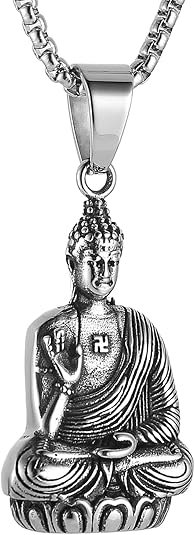
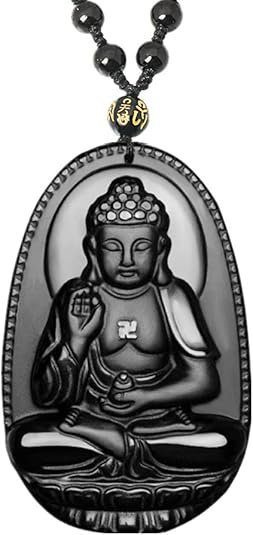
Material Variations and Their Significance
The materials used in Buddha necklaces aren’t merely aesthetic choices—they carry their own energetic properties and symbolic meanings that can enhance the pendant’s spiritual significance. Here’s how different materials influence the energy and meaning of your Buddha necklace:
Jade Buddha Necklaces
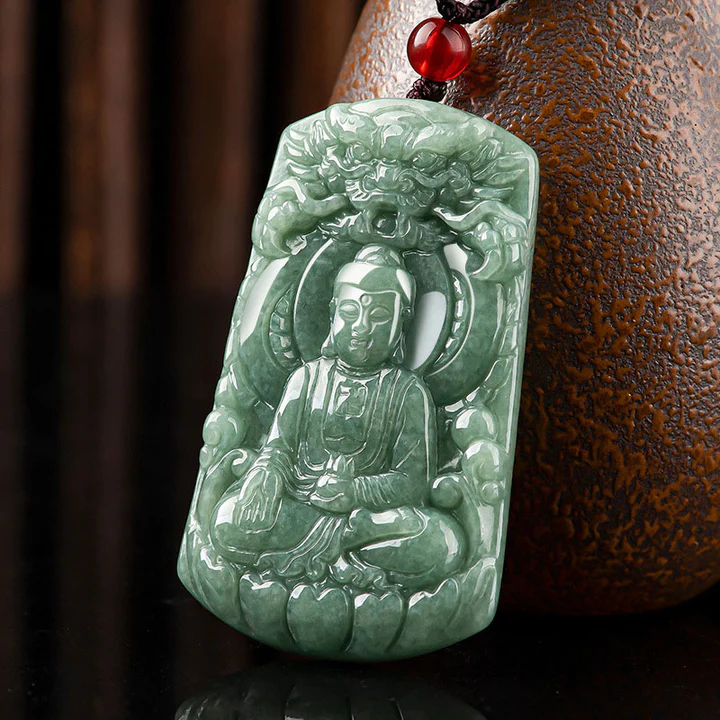
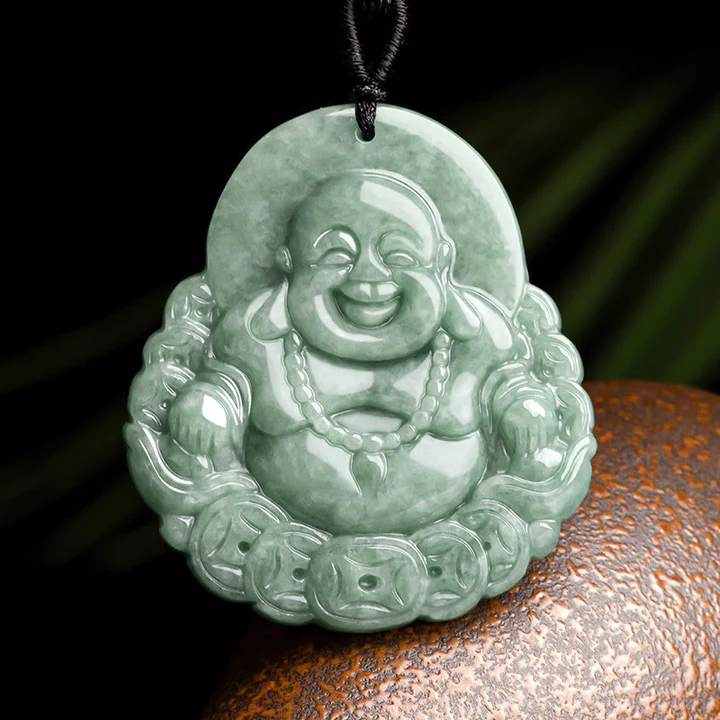
Jade has been revered in Asian cultures for thousands of years, particularly in China where it’s considered the “stone of heaven.” When carved into a Buddha pendant, jade creates a powerful spiritual tool that combines the Buddha’s enlightened wisdom with jade’s natural properties.
Jade is believed to:
- Promote harmony and balance in relationships
- Attract good fortune and abundance
- Offer protection from negative energies
- Support physical and emotional healing
The color of jade in your Buddha necklace also carries specific meanings:
Green Jade Buddha Necklace
Green jade symbolizes growth, renewal, and vitality. A green jade Buddha necklace fosters balance and harmony while promoting prosperity and abundance. Its connection to the heart chakra makes it particularly effective for emotional healing and cultivating compassion.
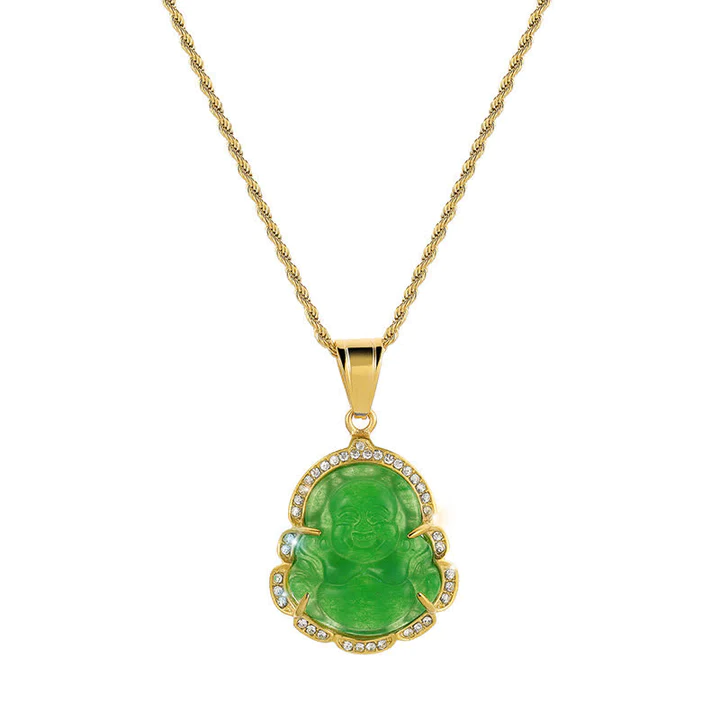
White Jade Buddha Necklace
White jade represents purity, clarity, and spiritual enlightenment. A white jade Buddha necklace helps clear mental fog and promotes clear thinking. It supports spiritual growth by removing obstacles and opening pathways to higher consciousness.
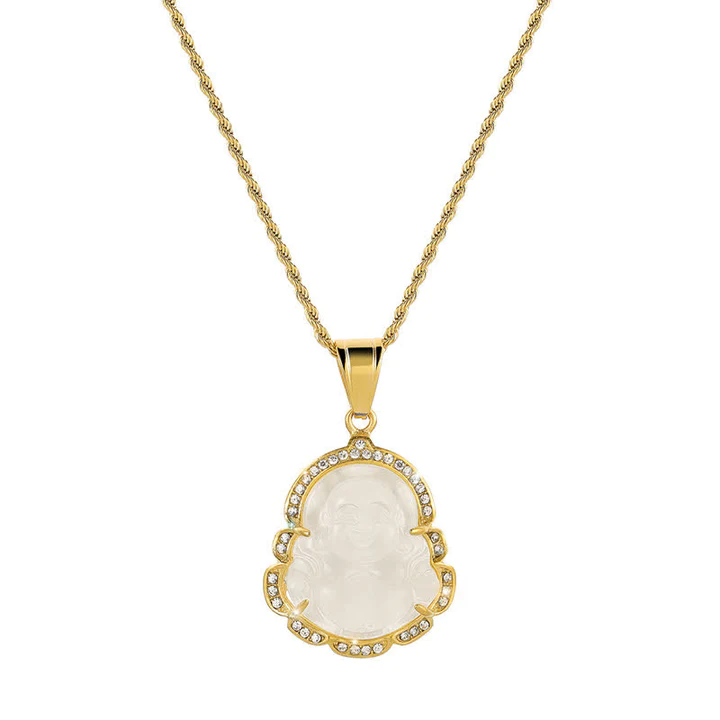
Black Jade Buddha Necklace
Black jade embodies protection, strength, and grounding. A black jade Buddha necklace serves as a powerful shield against negative energies while promoting inner strength and resilience during challenging times.
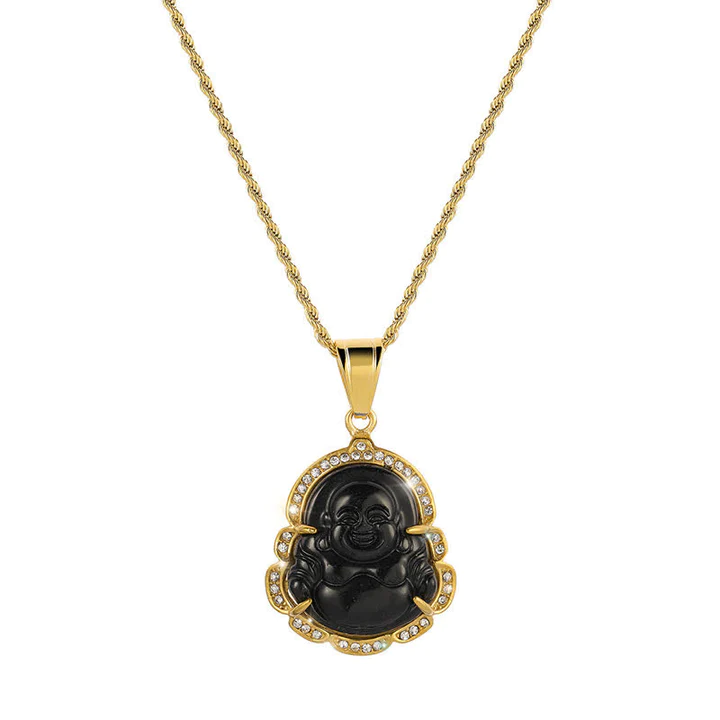
Purple Jade Buddha Necklace
Purple jade connects to spiritual awareness and intuition. A purple jade Buddha necklace enhances meditation practices by strengthening the connection between the physical and spiritual realms, promoting deeper insights and spiritual growth.
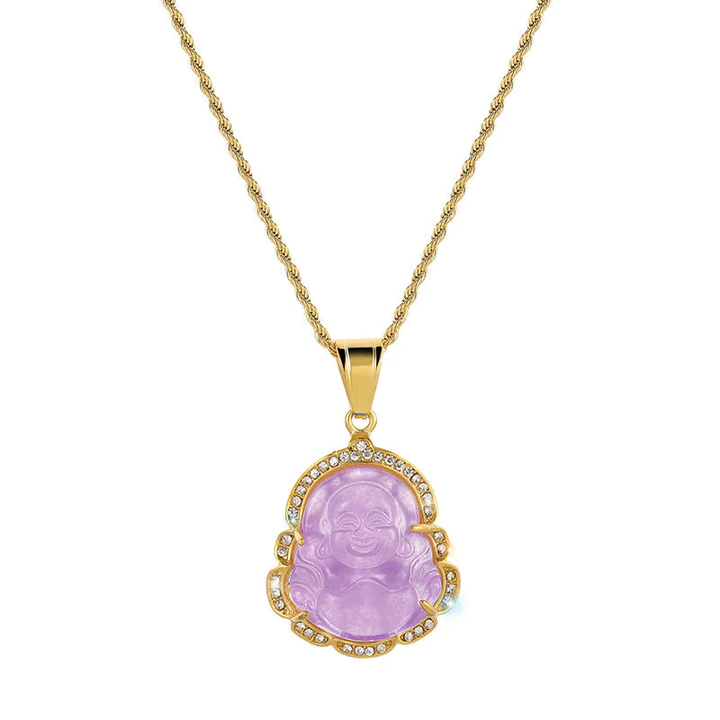
Blue Buddha Necklace
Blue, the color of the sky and sea, symbolizes depth, stability, and serenity. The Blue Buddha necklace encourages healing, both physically and emotionally. It promotes peace and serenity, helping wearers find calm in the chaos of life.
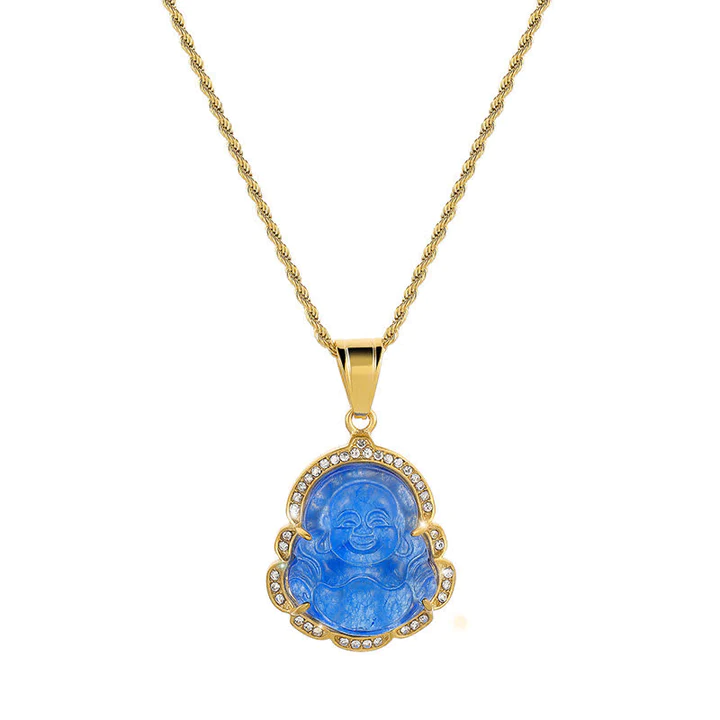
Yellow Buddha Necklace
Yellow, the color of sunshine, is associated with joy, happiness, and optimism. The Yellow Buddha necklace serves as a beacon of positivity, reminding wearers of the joys of life and the importance of friendships.
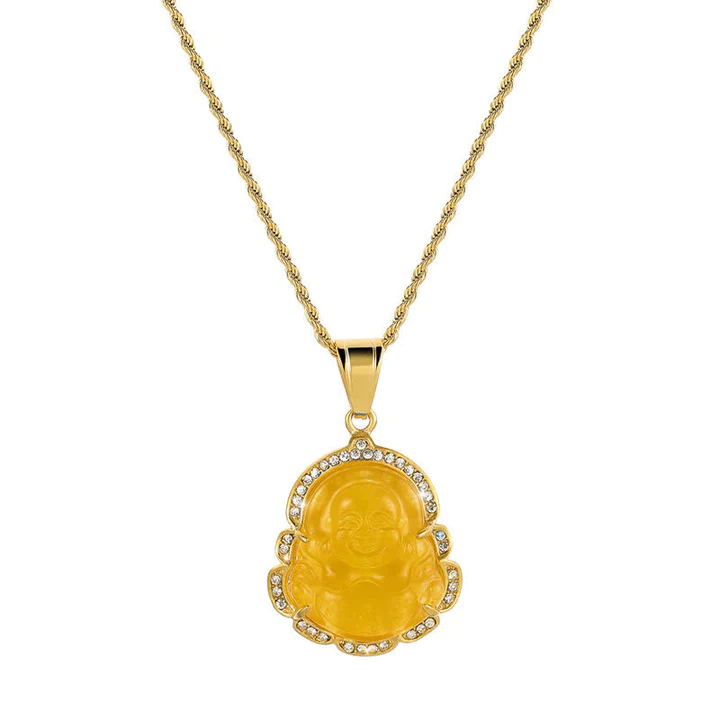
Red Buddha Necklace
Red is a vibrant color that symbolizes passion, energy, and love. The Red Buddha necklace is a testament to the power of love and passion in one’s life. It encourages wearers to pursue their passions fearlessly and to love deeply and unconditionally.

Pink Buddha Necklace
Pink is a gentle color that often represents compassion, nurturing, and love. The Pink Buddha necklace serves as a reminder of the importance of emotional healing. It encourages wearers to embrace love, not just romantically but also in a broader sense, nurturing relationships and fostering care and understanding.

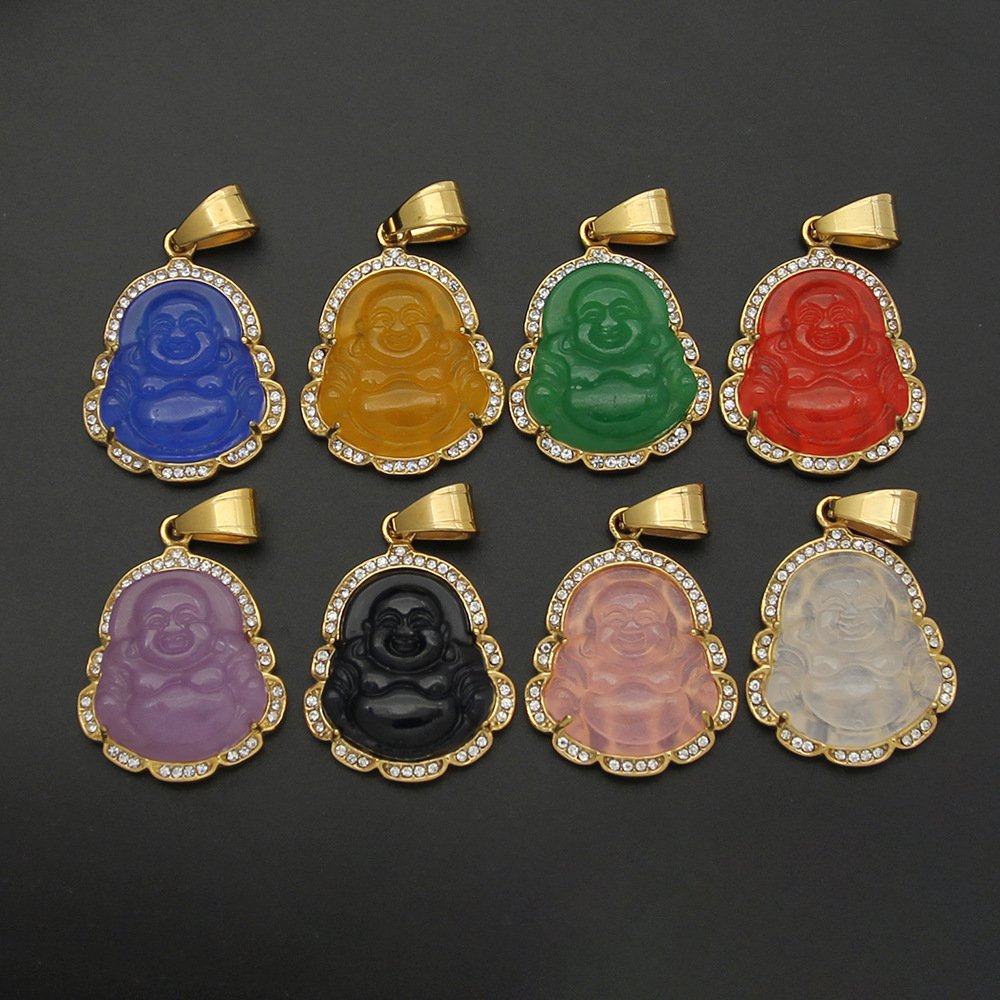
Obsidian Buddha Necklaces
Obsidian, a natural volcanic glass formed from rapidly cooled lava, creates powerful Buddha pendants with unique protective and grounding properties. Known for its ability to absorb and transmute negative energies, obsidian Buddha necklaces are particularly effective for:
- Psychic protection and shielding from negative influences
- Revealing truth and bringing hidden issues to light
- Grounding excessive spiritual energy
- Promoting emotional healing and release of past traumas
Dr. Robert Simmons, author of “The Book of Stones,” explains: “Obsidian acts as a mirror to the soul, reflecting back our shadow aspects so we can acknowledge, heal, and integrate them. When combined with the Buddha’s enlightened qualities, it creates a powerful tool for spiritual transformation.” The Book of Stones
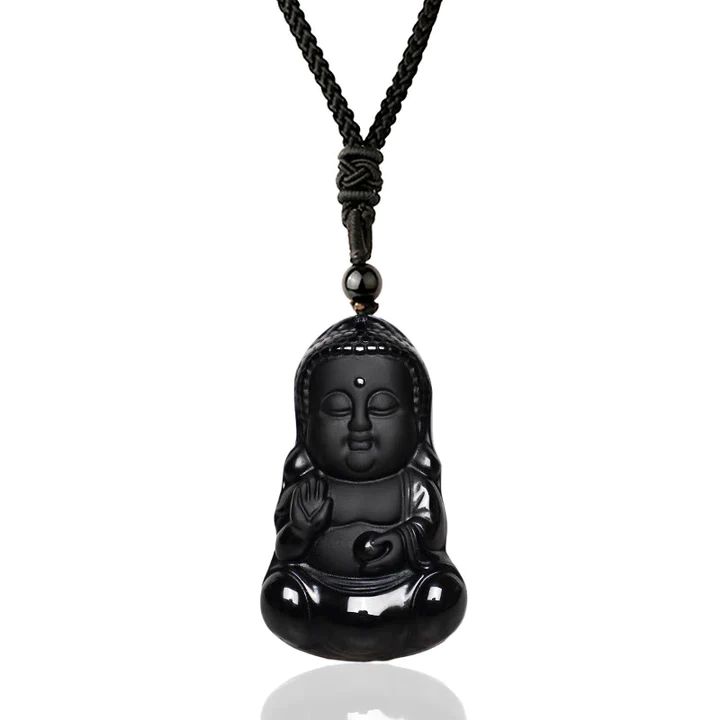
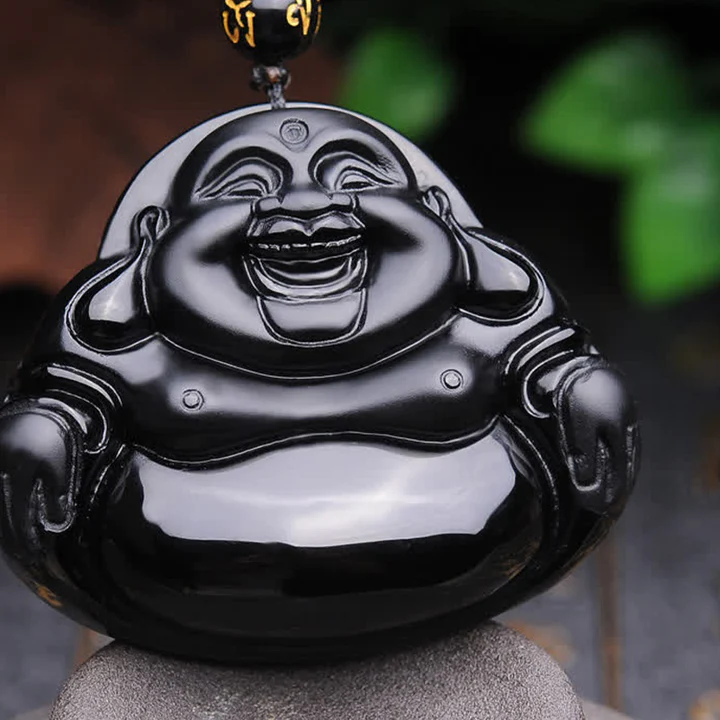
Crystal Buddha Necklaces
Crystal Buddha pendants harness the amplifying and clarifying properties of quartz crystal to enhance meditation and spiritual practices. Clear quartz, often called the “master healer,” is the most versatile crystal, but Buddha pendants are also crafted from:
- Rose Quartz Buddha: Promotes unconditional love, compassion, and emotional healing
- Amethyst Buddha: Enhances spiritual awareness, meditation, and intuition
- Citrine Buddha: Attracts abundance, success, and positive energy
- Smoky Quartz Buddha: Grounds spiritual energy and offers protection
The American Crystal Society states: “Crystals have been used in spiritual practices across cultures for thousands of years due to their unique molecular structures that interact with human energy fields in measurable ways.” American Crystal Society
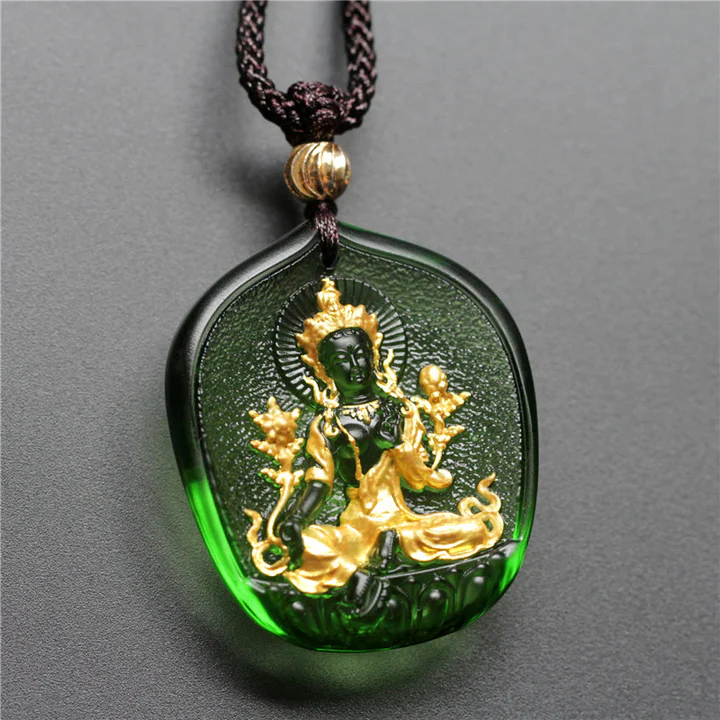
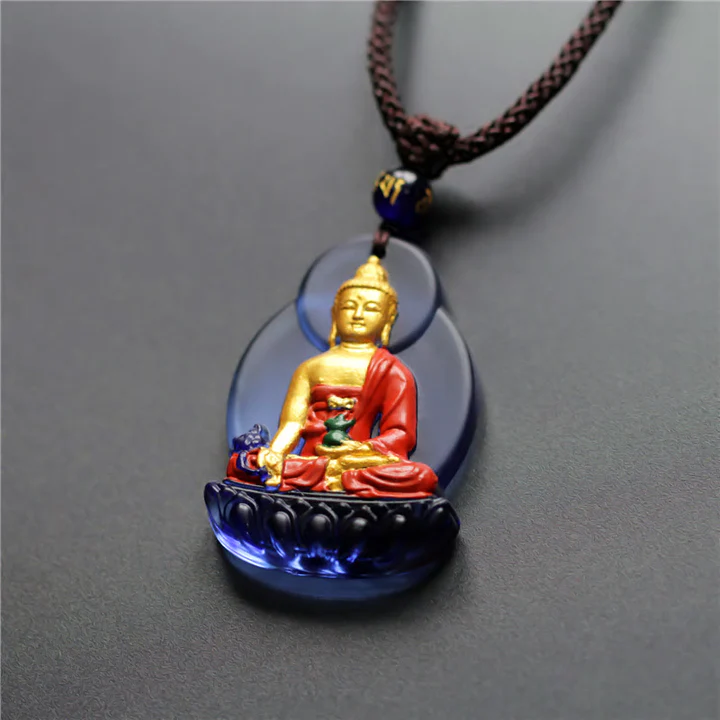
Gold and Silver Buddha Necklaces
Precious metals carry their own spiritual significance when used to create Buddha pendants:
Gold Buddha Necklaces symbolize:
- Solar energy and divine masculine qualities
- Enlightenment and spiritual illumination
- Strength, vitality, and power
- Abundance and prosperity
According to Vedic traditions, gold is considered the mineral of the sun, representing divine truth and immortality. A gold Buddha necklace combines these solar qualities with the Buddha’s enlightened wisdom. Journal of Indological Studies
Silver Buddha Necklaces represent:
- Lunar energy and divine feminine qualities
- Intuition, reflection, and emotional wisdom
- Purification and clarity
- Flow and adaptability
Silver has long been associated with the moon in many spiritual traditions, representing the receptive, intuitive aspects of consciousness. A silver Buddha necklace supports emotional balance and inner wisdom. Silver Institute
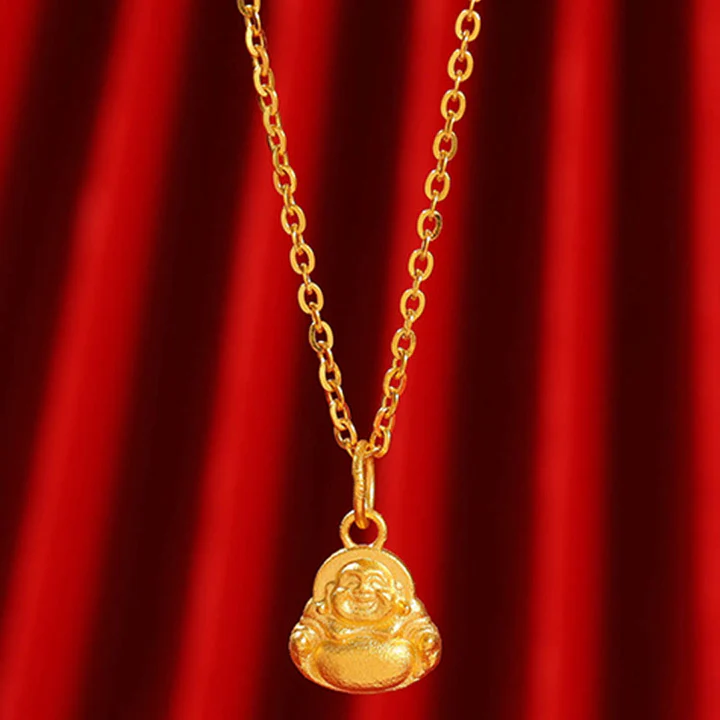
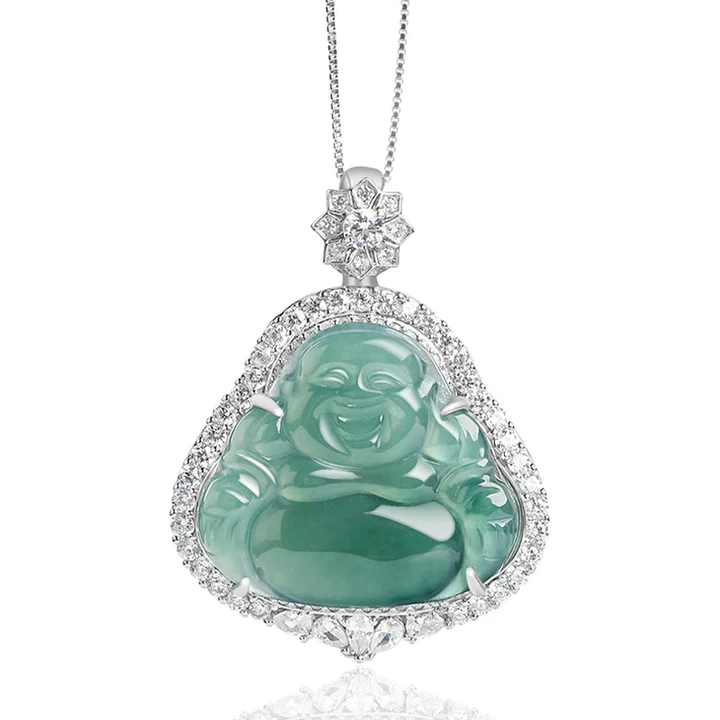
Wooden Buddha Necklaces
Wooden Buddha pendants connect the wearer to the natural world and the earth element. Different woods carry unique properties:
- Sandalwood Buddha: Enhances meditation, promotes tranquility, and purifies negative energy
- Rosewood Buddha: Grounds energy and promotes emotional stability
- Boxwood Buddha: Offers protection and supports personal growth
- Ebony Buddha: Provides spiritual protection and grounding
Wood has been used in spiritual objects across cultures for millennia, valued for its connection to the living world and natural elements. According to Buddhist tradition, the Buddha achieved enlightenment under the Bodhi tree, making wooden pendants particularly meaningful reminders of this sacred moment. Forest Research
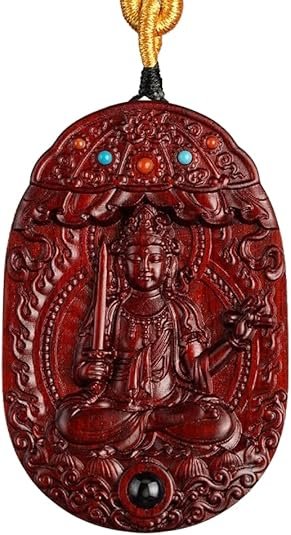
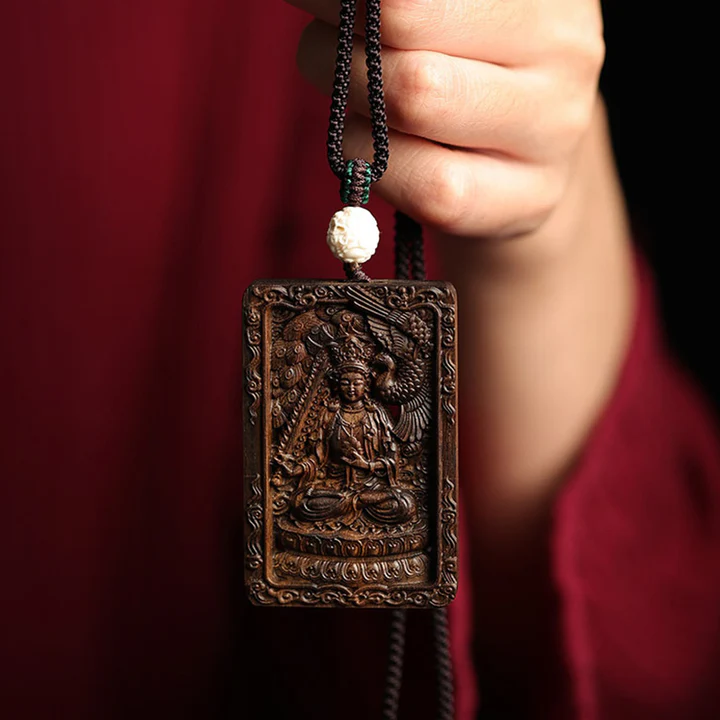
How to Choose the Right Buddha Necklace for You
Selecting a Buddha necklace is a deeply personal decision that goes beyond mere aesthetics. To find the pendant that will best support your spiritual journey, consider these essential factors:
Align with Your Spiritual Intentions
The most important factor in choosing a Buddha necklace is identifying what spiritual qualities or support you’re seeking in your life. Take time to reflect on your current challenges, aspirations, and spiritual goals:
- Seeking inner peace and calm? Consider a Meditating Buddha pendant that supports mindfulness and tranquility.
- Need protection from negative energies? An Abhaya (Protection) Buddha or black obsidian Buddha would serve you well.
- Wanting to attract abundance? A Laughing Buddha in jade or gold can help manifest prosperity.
- Looking for wisdom and clarity? A Teaching Buddha pendant supports intellectual growth and clear insight.
- Facing challenges that require strength? The Earth-Touching Buddha reminds you of your inner resilience.
Tibetan Buddhist practitioner and author Pema Chödrön advises: “Choose symbols that remind you of the qualities you wish to cultivate. The external form is a mirror for the internal transformation you seek.” Pema Chödrön Foundation
Consider Material Properties
Different materials interact with your personal energy in unique ways. When selecting your Buddha necklace, consider both the symbolic associations and how the material feels to you personally:
- Highly sensitive individuals might prefer the gentle, nurturing energy of wood or rose quartz.
- Those needing grounding could benefit from obsidian, black jade, or smoky quartz.
- People seeking energy amplification might choose clear crystal or gold.
- Those in healing professions might be drawn to jade or amethyst for their supportive qualities.
Trust your intuitive response to different materials. When possible, hold the pendant before purchasing and notice which materials feel most resonant with your energy.
Examine Craftsmanship and Authenticity
A Buddha necklace is a sacred object deserving of skilled craftsmanship and respectful creation. Look for:
- Fine detailing that captures the Buddha’s features with accuracy and reverence
- Smooth, even finish without rough edges or poor-quality carving
- Ethically sourced materials that respect both environmental and human rights concerns
- Authentic traditional techniques when possible, especially for culturally specific styles
Remember that mass-produced Buddha pendants may lack the energetic qualities and attention to detail found in artisanal pieces. When possible, purchase from artisans who understand the spiritual significance of the images they create.
The Cultural Heritage Foundation notes: “Authentic spiritual items created with proper intention and respect carry an energetic quality that mass-produced items often lack. The mindfulness of the craftsperson becomes part of the object itself.” Cultural Heritage Foundation
Balance Budget with Quality
While cost shouldn’t be the primary consideration for spiritual jewelry, it’s important to find a balance between your budget and acquiring a quality piece that will serve you well. Consider:
- Investing in a single high-quality piece rather than multiple lower-quality options
- Looking for artisans who price fairly based on materials and craftsmanship
- Understanding that extremely low prices often indicate problematic sourcing or manufacturing
- Viewing your Buddha necklace as a long-term spiritual companion worthy of appropriate investment
Remember that in traditional Buddhist contexts, the value of sacred objects lies not in their material worth but in the sincere intention behind them and the spiritual practice they support.
Cultural Respect and Appropriation Awareness
When wearing Buddhist imagery, it’s important to approach these symbols with appropriate respect and understanding:
- Educate yourself about the basic meanings of the Buddha image you choose
- Wear the pendant mindfully, treating it as a sacred object rather than merely decorative
- Be prepared to engage respectfully if asked about your pendant’s significance
- Consider supporting Buddhist artisans or organizations when purchasing
Buddhist teacher and author Lama Rod Owens suggests: “When non-Buddhists engage with Buddhist imagery, doing so with respect, education, and an open heart transforms potential appropriation into appreciated cultural exchange.” Buddhist Peace Fellowship
The Benefits of Wearing a Buddha Necklace
Beyond their aesthetic appeal, Buddha necklaces offer numerous spiritual and practical benefits to those who wear them with intention and respect:
Spiritual Connection and Mindfulness
A Buddha necklace serves as a physical reminder of spiritual principles throughout your day. The simple act of touching or seeing your pendant can:
- Bring your awareness back to the present moment
- Remind you of your spiritual aspirations and values
- Create brief opportunities for mindfulness in busy moments
- Serve as a portable meditation aid
Research in contemplative neuroscience suggests that physical reminders like religious or spiritual symbols can help anchor mindfulness practices in daily life. Dr. Richard Davidson of the Center for Healthy Minds explains: “Tangible reminders of our contemplative intentions help bridge formal practice with everyday awareness, creating neural pathways that support ongoing mindfulness.” Center for Healthy Minds
Emotional Regulation and Stress Reduction
Many wearers report that their Buddha necklace provides emotional support during challenging situations:
- The pendant becomes a touchstone during stressful moments
- The symbolic meaning offers perspective during emotional turbulence
- The physical connection provides comfort and grounding
- The reminder of Buddhist principles helps maintain equanimity
A 2022 study in the Journal of Complementary and Alternative Medicine found that touching personally meaningful spiritual objects activated parasympathetic nervous system responses associated with reduced stress and improved emotional regulation. Journal of Complementary and Alternative Medicine
Protection and Spiritual Shielding
Across many spiritual traditions, sacred pendants are believed to offer protection to the wearer:
- Creating an energetic shield against negative influences
- Attracting positive energies while deflecting harmful ones
- Serving as a spiritual ally during challenging encounters
- Providing a sense of safety and divine connection
While scientific evidence doesn’t directly support metaphysical protection, psychological research confirms that meaningful symbols can increase feelings of security and resilience. The placebo effect—real physiological changes resulting from belief—can create measurable protective benefits for those who have faith in their spiritual jewelry. American Psychological Association
Community and Connection
Wearing a Buddha necklace can create meaningful connections with others:
- Identifying you to like-minded spiritual seekers
- Creating opportunities for conversations about spiritual practice
- Connecting you with Buddhist communities and practitioners
- Serving as a visible reminder of your values and beliefs
Social psychologist Dr. Emily Kingston notes: “Visible spiritual symbols function as both personal reminders and social signals, creating opportunities for meaningful connection while strengthening our commitment to our chosen values and practices.” Social Psychology Quarterly
Caring for Your Buddha Necklace
To maintain both the physical integrity and spiritual potency of your Buddha necklace, proper care is essential:
Physical Care and Maintenance
Different materials require specific care approaches:
- Jade and crystal: Clean with a soft, dry cloth. For deeper cleaning, use mild soap and water, rinsing thoroughly and drying completely.
- Silver: Use a silver polishing cloth to remove tarnish. Avoid harsh chemicals.
- Gold: Clean with warm water and mild soap. Dry thoroughly with a soft cloth.
- Wood: Wipe with a slightly damp cloth and occasionally treat with natural oils like jojoba.
- Obsidian: Clean with a soft, dry cloth. Avoid harsh chemicals or ultrasonic cleaners.
For all Buddha pendants, regardless of material:
- Remove before swimming, bathing, or heavy physical activity
- Store separately from other jewelry to prevent scratching
- Keep away from direct sunlight for extended periods
- Avoid exposure to perfumes, lotions, and chemicals
Spiritual Maintenance
Many traditions suggest that spiritual jewelry benefits from periodic energetic cleansing and recharging:
- Moonlight cleansing: Place your pendant in the light of the full moon overnight.
- Smudging: Pass your necklace through the smoke of sacred herbs like sage or palo santo.
- Sound cleansing: Use a singing bowl or bell to cleanse the pendant with sound vibrations.
- Intention renewal: Hold your pendant and consciously reaffirm your spiritual intentions.
Buddhist teacher Yongey Mingyur Rinpoche suggests: “Objects used in spiritual practice become containers for our intentions. Periodically renewing our connection to these objects through mindful attention refreshes both the object and our relationship with it.” Tergar Meditation Community
The Sociocultural Impact of Wearing a Buddha Necklace
Wearing Buddhist imagery connects you to broader social and cultural contexts that are important to understand:
Ethical Considerations and Cultural Respect
Buddha pendants are more than decorative objects—they represent a living spiritual tradition practiced by millions worldwide. Approach wearing Buddhist imagery with appropriate respect:
- Learn about Buddhist principles: Understand the basic meanings behind the imagery you wear.
- Avoid trivializing sacred symbols: Don’t wear Buddha pendants solely as fashion accessories without appreciation for their meaning.
- Be mindful of context: Some situations may not be appropriate for displaying religious symbols of any tradition.
- Respond respectfully to questions: If asked about your pendant, acknowledge its spiritual significance.
Dr. Karma Lekshe Tsomo, Buddhist nun and professor of Buddhism, explains: “When non-Buddhists wear Buddhist symbols with respect and understanding, it can be a bridge to greater cross-cultural appreciation, but when worn carelessly, it can feel disrespectful to practitioners who hold these images as sacred.” International Association of Buddhist Women
The Bridge Between Eastern and Western Spirituality
Buddha necklaces often serve as entry points for Western spiritual seekers interested in Eastern philosophies:
- They spark curiosity about Buddhist concepts and practices
- They create opportunities for cross-cultural dialogue and understanding
- They represent the growing integration of diverse spiritual traditions
- They reflect the universality of certain spiritual principles across cultures
Religious scholar Dr. Thomas Armstrong observes: “Sacred symbols traveling across cultural boundaries have facilitated spiritual exchange throughout human history. Today’s popularity of Buddhist imagery in the West represents a continuation of this ancient pattern of cross-pollination between spiritual traditions.” Journal of Interreligious Studies
Fashion, Spirituality, and Authenticity
The mainstream popularity of Buddha necklaces raises questions about the intersection of fashion and spirituality:
- When does appreciation become appropriation?
- How can spiritual symbols maintain their sacred meaning in commercial contexts?
- What responsibilities do manufacturers and sellers have?
- How can wearers engage authentically with spiritual symbols?
Cultural anthropologist Dr. Rebecca Wong suggests: “The key distinction lies in intention and relationship. Wearing spiritual symbols with genuine respect, ongoing education, and authentic connection to their meaning transforms potential appropriation into meaningful spiritual practice, regardless of one’s cultural background.” Journal of Material Culture
FAQs About Buddha Necklaces
Can anyone wear a Buddha necklace, or is it only for Buddhists?
While Buddha necklaces have their origins in Buddhist spiritual practice, they have become widely worn by people of various faiths and spiritual backgrounds. The key consideration is your intention and the respect with which you approach the symbol.
For non-Buddhists, wearing a Buddha pendant can be appropriate when done with:
- Sincere appreciation for the wisdom and compassion the Buddha represents
- Basic understanding of the symbolism and its significance
- Respect for Buddhist traditions and practitioners
- Personal connection to the qualities the Buddha embodies
Buddhist teacher Jack Kornfield notes: “The Buddha never intended his image to be restricted only to formal Buddhists. The qualities of wisdom, compassion, and awakening he represents are universal human capacities that all can aspire to cultivate.” Spirit Rock Meditation Center
What is the proper way to wear a Buddha necklace?
While there aren’t strict religious rules for wearing Buddha pendants, these guidelines promote respectful practice:
- Traditionally, the Buddha image should not be below the waist
- Many practitioners prefer wearing the pendant over the heart chakra
- The Buddha should face outward (away from your body) in most traditions
- Remove the necklace during activities that might be considered disrespectful (excessive alcohol consumption, sexual activity, etc.)
- Avoid wearing the pendant in inappropriate environments like bathrooms
Most importantly, wear your Buddha necklace mindfully, being aware of its presence and meaning throughout your day.
How do I know if a Buddha necklace is authentic and respectfully made?
Authentic, respectfully crafted Buddha pendants typically:
- Show fine attention to detail in the Buddha’s features and proportions
- Come from artisans or companies that demonstrate knowledge of Buddhist traditions
- Are made from quality materials appropriate to the image
- Are accompanied by information about the Buddha’s meaning and symbolism
- Are priced fairly to reflect skilled craftsmanship and quality materials
Avoid mass-produced pendants from companies that treat the Buddha as merely decorative or that use inappropriate imagery (e.g., Buddha heads separated from bodies, which can be considered disrespectful in many Buddhist traditions).
Can I wear multiple Buddha necklaces together?
Yes, many practitioners wear multiple Buddha pendants that complement each other energetically and symbolically. Consider combinations like:
- Different Buddha forms that represent complementary qualities (e.g., Protection Buddha and Meditating Buddha)
- The same Buddha form in different materials for enhanced energetic properties
- Buddha pendants with other spiritual symbols that align with your practice
When wearing multiple pendants, be mindful of how they interact physically (to avoid tangling or damage) and energetically (some traditions suggest certain combinations work better than others).
How do I cleanse and charge my Buddha necklace?
To maintain your Buddha necklace’s spiritual potency:
Physical cleansing:
- Gently clean with appropriate methods for the specific material
- Use soft cloths and mild soaps when needed
- Rinse thoroughly and dry completely
Energetic cleansing:
- Moonlight: Place in the light of the full moon overnight
- Sunlight: Brief exposure to morning sunlight (avoid prolonged exposure for jade and some crystals)
- Sacred smoke: Pass through the smoke of sage, palo santo, or incense
- Sound: Use singing bowls, bells, or mantras to cleanse with sound vibrations
- Salt: Place near (not touching) Himalayan salt overnight
Charging and blessing:
- Hold the pendant while meditating or reciting mantras
- Place on your altar or sacred space regularly
- Bring to a temple or spiritual place for blessing
- Visualize light filling and energizing the pendant
What is the significance of the different Buddha poses in necklaces?
Each Buddha pose (mudra) carries specific meanings and energies:
- Meditation Pose (Dhyana Mudra): Promotes concentration, inner peace, and mindfulness
- Teaching Pose (Vitarka Mudra): Enhances wisdom, learning, and the sharing of knowledge
- Earth-Touching Pose (Bhumisparsha Mudra): Strengthens determination, grounding, and overcoming obstacles
- Protection Pose (Abhaya Mudra): Offers security, fearlessness, and shielding from negativity
- Reclining Buddha: Represents the Buddha’s passing into Nirvana and complete liberation
- Walking Buddha: Symbolizes grace in movement and the active spread of dharma teachings
Choose the pose that most resonates with what you seek to cultivate in your life.
Conclusion: The Transformative Potential of Buddha Necklaces
A Buddha necklace is far more than a decorative accessory—it’s a powerful tool for spiritual growth, mindfulness, and personal transformation. By wearing the Buddha’s image with understanding and respect, you carry with you a physical reminder of the potential for awakening that exists within all beings.
Whether you’re drawn to the Buddha as a spiritual guide, a symbol of inner peace, or a representation of the qualities you wish to cultivate, your necklace can serve as a daily touchstone for your practice and aspirations. Each time you see, touch, or think about your pendant, you have an opportunity to reconnect with your intentions and the timeless wisdom the Buddha represents.
The diverse styles, materials, and forms of Buddha necklaces allow you to find the perfect pendant that resonates with your unique spiritual journey. From the joyful abundance of the Laughing Buddha to the serene concentration of the Meditating Buddha, from the vibrant energy of jade to the protective power of obsidian, these sacred adornments offer both beauty and spiritual significance.
As you move through the world wearing your Buddha necklace, you become part of a global community spanning thousands of years—those who have found meaning, comfort, and inspiration in the Buddha’s teachings. Your mindful engagement with this symbol honors both the rich spiritual tradition from which it comes and your own authentic path of growth and awakening.
May your Buddha necklace serve as a constant reminder of your innate capacity for wisdom, compassion, and peace—the very qualities the Buddha embodied and that exist as potential within each of us.
Disclaimer:
We earn a commission at no extra cost to you if you click a link and make a purchase
References
- Oxford Research Encyclopedia of Religion. (2023). “The Life of the Buddha: Historical Context and Religious Significance.” Oxford University Press
- Metropolitan Museum of Art. (2024). “Buddhist Art and Iconography: Evolution of the Buddha Image.” The Met
- Journal of Buddhist Ethics. (2023). “Contemporary Applications of Buddhist Symbolism.” Dickinson College Blogs
- Buddha’s Light International Association. (2024). “The Laughing Buddha: History and Symbolism.” BLIA
- Center for Mindfulness. (2024). “Mindfulness Practice and Symbolic Representation.” University of Massachusetts Medical School
- Sravasti Abbey. (2024). “Buddhist Teachings on Wisdom and Compassion.” Sravasti Abbey
- Gemological Institute of America. (2024). “Jade in Buddhist Culture and Art.” GIA
- Simmons, R. (2022). “The Book of Stones: Who They Are and What They Teach.” Inner Traditions
- American Crystal Society. (2024). “Crystals in Spiritual Practice.” American Gem Society
- Journal of Indological Studies. (2023). “Gold and Silver in Vedic and Buddhist Traditions.” JSTOR
- Silver Institute. (2024). “Silver in Religious Artifacts and Symbolism.” Silver Institute
- Forest Research. (2023). “Properties and Significance of Woods in Religious Objects.” Forest Research UK
- Pema Chödrön Foundation. (2024). “Symbols as Tools for Transformation.” Pema Chödrön Foundation
- Cultural Heritage Foundation. (2023). “Craftsmanship and Energy in Sacred Objects.” Cultural Heritage Foundation
- Buddhist Peace Fellowship. (2024). “Cultural Exchange and Appreciation in Buddhism.” Buddhist Peace Fellowship
- Center for Healthy Minds. (2024). “Mindfulness Tools and Neural Pathways.” University of Wisconsin-Madison
- Journal of Complementary and Alternative Medicine. (2022). “Physical Objects and Emotional Regulation in Spiritual Practice.” Liebert Pub
- American Psychological Association. (2023). “Symbols and Psychological Well-being.” APA
- Social Psychology Quarterly. (2024). “Religious Symbols as Social Identifiers.” Sage Journals
- Tergar Meditation Community. (2024). “Objects in Meditation Practice.” Tergar
- International Association of Buddhist Women. (2023). “Cultural Respect and Buddhist Symbols.” Sakyadhita
- Journal of Interreligious Studies. (2024). “Cross-Cultural Spiritual Exchange in History.” Journal of Interreligious Studies
- Journal of Material Culture. (2023). “Spiritual Symbols in Contemporary Fashion.” Sage Journals
- Spirit Rock Meditation Center. (2024). “Universal Teachings of the Buddha.” Spirit Rock
- Buddha3Bodhi. (2024). “The Ultimate Guide to Buddhist Necklaces: Meaning, Styles, and FAQs.” Buddha3Bodhi
- QiLing Aura. (2024). “Why Wear a Buddha Necklace? Unveiling the Hidden Power of Spiritual Jewelry.” QiLing Aura
- Supreme Mantra. (2024). “A Full Guide to Buddha Necklace: Meaning and Benefits.” Supreme Mantra
- Buddha and Karma. (2024). “Buddha Necklace: Meaning & Benefits.” Buddha and Karma



